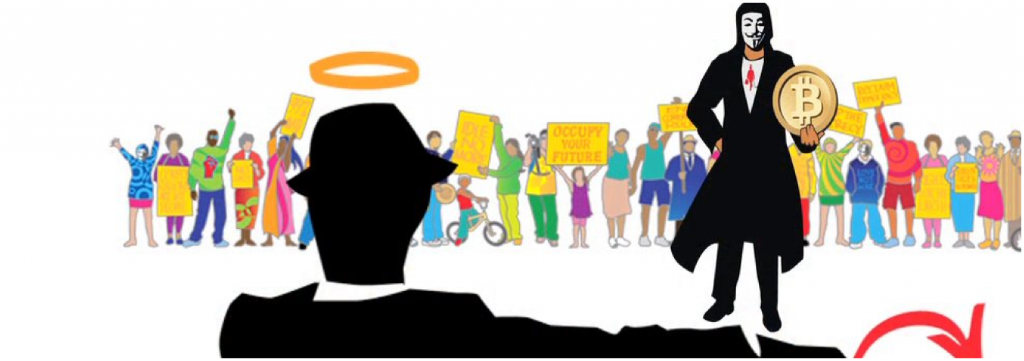This story is in issue 20
In my pocket, I have an old leather wallet. It contains enough banknotes to buy a brand new wallet of a better model I saw in a magazine. This buying power belongs to just me: I am the only one who can use those notes to buy anything. Likewise, if I transfer them to another person, then instead of me, only this other person will own their buying power.
Yet even if my transferring away my banknotes can always transfer along their control, it could never transfer along their property, which is not only mine. The notes, as representations of money, do not belong to just me. For example, I have no right to create or destroy them: they are public. What belongs to just me or only to whoever else controls any such notes is rather their buying power, which hence must be private.
Indeed, if my banknotes were only mine, then I could transfer them away by selling them, not as money, but rather as purely concrete objects. However, this would prevent me at least temporarily from using those notes to buy anything. So by recognizing the buying power they then would lose as their monetary value and their instead keeping this value as its representation, we can conclude:
- All monetary value must be private.
- Its representation must be public, or unsellable.
Still, if not me, then who else can sell, buy, create, or destroy those banknotes? This question should be negligible if what I own is their monetary value rather than the notes themselves. However, if selling, buying, creating, or destroying them can change their individual monetary value, then the same question becomes critical.
Privately Public Money
Distinguishing the letter “a” from its verbal sound would prevent this visual representation of that sound. Likewise, distinguishing a banknote from its monetary value would prevent this concrete, objective representation of that value.
The resulting confusion (indistinction) between a representation and what it represents must happen to all representations of something dependent on them by something independent from them. Indeed, the letter “a” does not depend on its visually represented verbal sound, or a banknote on its monetary value. Likewise, an electronic account does not depend on its balance, nor a precious-metal amount on its buying power. Anything both dependent on its representation and represented by something independent from representing it becomes indistinguishable from that representation.
Additionally, only concrete objects can remain independent from what they represent. So letters (like “a”), banknotes, precious metals, or electronic accounts, even if just imagined, are all concrete objects. While conversely, all purely concrete, objective representations of money must remain indistinguishable from their monetary value, despite any such value and its representation being always respectively private and public.
So every purely concrete, objective representation of its own monetary value is inherently problematic: its indistinction from the private value it publicly represents must privatize this whole public representation of that value. As thus, any such representation requires an impossibly private control of its always necessarily public, unsellable self, whether by people selling, buying, creating, or destroying it.
Even so, I can still control the monetary value of my banknotes. Indeed, we have long represented that value with objects as purely concrete as those notes, including precious metals and electronic accounts. Yet how could we do it? How did we solve the ownership conflict inherent in their privately public representation of money? How could all those privately controlled monetary representations remain public? The solution was to delegate their private control to a public monetary authority.
By no other means can we privately control what is always necessarily public: only the public delegation of a still private control can privately publicize it, the collective name for all delegates resulting from which is a government. So any purely concrete, objective representation of money requires its own general control by a government.
However, privately and publicly controlling one same thing are still mutually exclusive. So even if public, the monetary authority of a government that privately controls all money must rather be private. Eventually, this conflict will segregate any monetary authority of that government into a private part of its public self: a central bank. Indeed, any such government could only remain public as long as just part of it becomes private. Then, its public whole will be private by delegating all its monetary control to that private part of itself, which conversely will be public just by belonging to that same whole.
Finally, regardless of government organization, a still purely concrete, objective representation of money remains necessarily private, or privately public to whole governments, even if already private to their central banks. For which to be possible, a government must create its privately public money by borrowing it from its own central bank. So it not only buys the created money from its own private self, or sells it to its own public self, but also destroys that money by paying it back to the same central bank, if ever. While conversely, that bank becomes the original creditor of this privately created, publicly loaned money, as of any additional money created for paying its interest, then with the resulting inflation and recursive interest payments, of an increasing fraction of all monetary value.
Still, even in the absence of any central bank, once commercial banks create money by loaning it to people who then use that money to buy public debt, or even just pay public taxes, a government already borrows its money from the banking system, despite indirectly. Then, the partial privatization of that government only lacks a formal, institutional expression.
Purely Public Money
Unlike the symbol for a verbal sound, that verbal sound itself needs not become indistinguishable from what it means. For example, the sound of the word “everything” needs not itself be everything to mean it. Unlike its visual representation, that sound is not recognizable as a representation but rather as what it represents, from which it must hence be always distinguishable.
Yet verbal sounds are not the only representations always necessarily distinguishable from their meaning. To find another example of such representations, let us imagine a public rule by which, somehow, the number three publicly represents the number five only privately to me. Under that rule, the number three publicly represents any possible number, which is the actual number five only privately to me—to whom alone the number five conversely represents the number three.
Additionally, let us imagine we can generalize this whole public representation (by three) of a converse private one (of three by five). Then, we could publicize the representation of any private number (like five) by a public one (like three) without conversely publicizing the representation of this public (the three-like) number by that private (the five-like) one. Public-key cryptography does precisely that: it uses two keys—two numbers—mathematically related in such a way that, although either key can only represent the other, only the private one can reveal its represented key. Then:
- Using the public key to encrypt any content results in another content that only a holder of the private key can decrypt.
- Using the private key to sign any content results in another content that every holder of the public key can authenticate.
With public-key cryptography, a monetary system can finally avoid privatizing the public representation of money, by representing any monetary value as a private key then representing this private key, or metarepresenting its represented monetary value as the corresponding public key. For example, the Bitcoin monetary system uses public-key cryptography to build signature chains, each link of which representing a monetary balance transfer, or transaction. In Bitcoin, transferring a monetary balance from a source public key to a target one requires combining the target key with the transaction that resulted in the same balance, then signing this combination with the private key still controlling that balance. After which, any holder of the source public key can authenticate this transaction as originating from whoever could sign it—necessarily by holding the corresponding private key.
Then, money becomes a privately signed yet public chain of monetary transactions despite never becoming itself public. For the first time in monetary history, representing a private monetary value (as a private key) does not require any control of its public representation (as a public key). With such a metarepresented money, or metamoney, a public abstraction (that of a public key) can represent a private monetary value (that of a private key) without ever becoming itself private—which makes its private control by any public monetary authority not only unnecessary, but also impossible.
Indeed, publicly expropriating money, whether by selling, buying, creating, or destroying it, requires privately controlling its public representation. Consequently, when this representation is purely public, a privately public authority cannot expropriate an increasing fraction of all monetary value, of which the public representation it no longer controls. While conversely, avoiding this privately public, increasingly expropriating control requires the public representation of money to remain entirely distinct from its private value, by representing the quantity rather than qualities of that value—being thus fungible—as all qualities of a monetary value belong rather to its representation, from which, to keep those qualities, it must remain indistinguishable.
Likewise, a monetary authority can only be centralized—in a government or central bank—by remaining privately public, hence by still controlling a privately public representation of money. So conversely, to control a purely public representation of that money, this monetary authority must become decentralized—in a metamonetary system, like Bitcoin.
For a deeper explanation of how and why any privately public money must eventually become an interest-paying debt, please read my book Representational Monetary Identity.
The post Public Money: Avoiding Its Privatization appeared first on Bitcoin Magazine.














